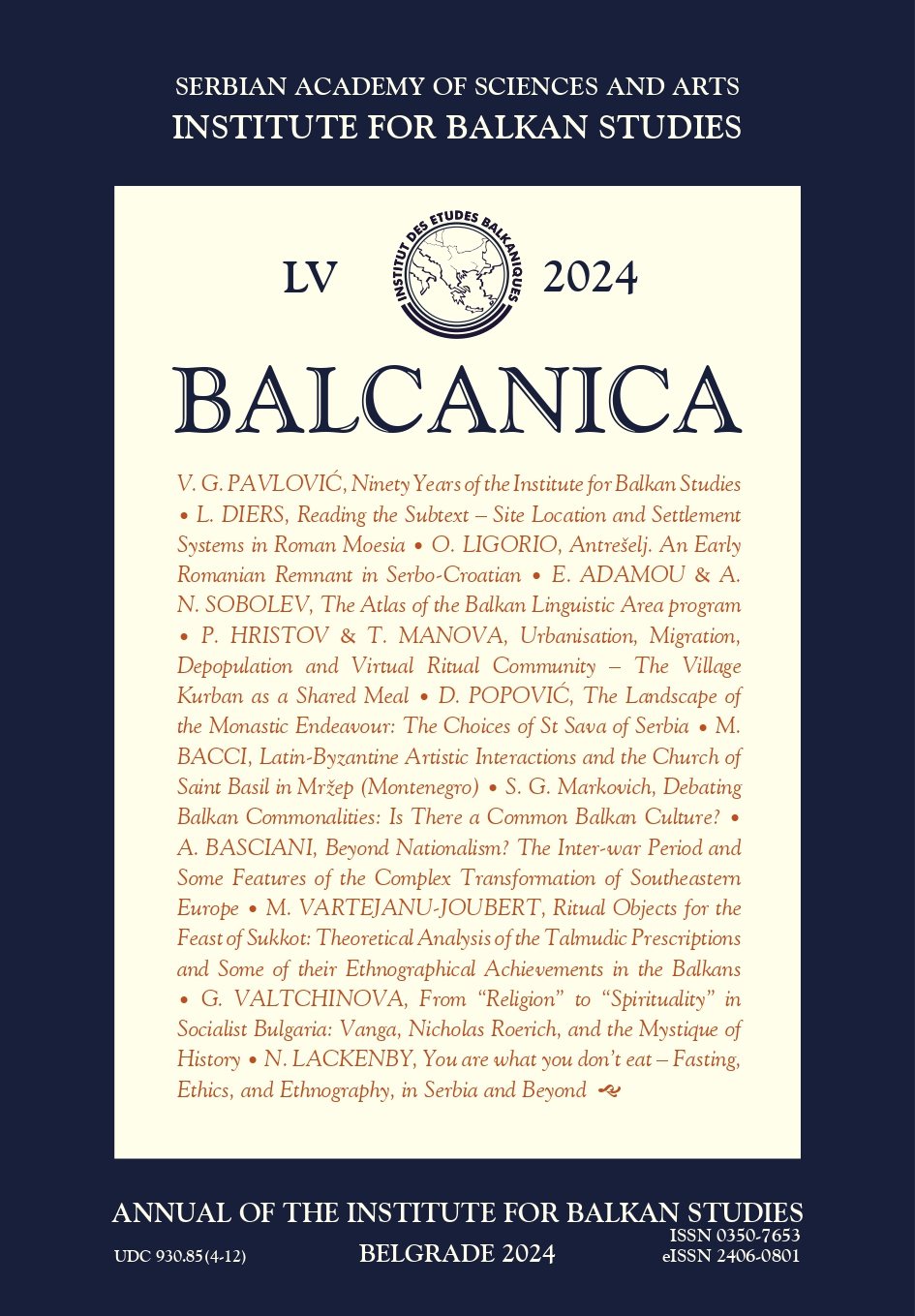Ritual Objects for the Feast of Sukkot: Theoretical Analysis of the Talmudic Prescriptions and Some of their Ethnographical Achievements in the Balkans

Published 01.12.2018
Keywords
- rabbinic Judaism,
- ritual object,
- anthropology,
- nature,
- artifice
- Sukkot,
- lulav,
- skhakh,
- Descola ...More
How to Cite
Copyright (c) 2024 Balcanica - Annual of the Institute for Balkan Studies

This work is licensed under a Creative Commons Attribution-NonCommercial-NoDerivatives 4.0 International License.
Abstract
Can we think of the artifact as an integral part of an anthropology of life as it has developed in the wake of the anthropology of nature founded by Philippe Descola? Judaism clearly fits within this perspective since a vast body of normative texts, notably the Babylonian Talmud, defines and discusses the jewishness of artifacts – whether ritual or everyday – by endeavoring to determine their correct position on a graduated scale ranging from nature to artifice, understood here as emic categories. This article aims to support this reflection by studying two ritual objects related to the festival of Sukkot: the skhakh, the roof of the sukka hut, and the lulav, the bouquet of the four species. As we shall see, the making of the ritual object according to specific rules shows us its place in the encounter with the supernatural, the goal towards which any ritual device aspires. After a theoretical analysis of the Talmudic prescriptions, we will look at some of the practical ways in which the Sukkot hut can be documented photographically in the Balkans, in the broadest sense of the term. We will present examples from Greece, Romania and Bulgaria.
Metrics
References
- Albert, J.-P. and A. Kedzierska-Manzon. “Des objets-signes aux objets-sujets.” Archives de sciences sociales des religions 174 (2016), 13–25.
- Arieli, S. “‘Pri Etz Hadar’ – Fruit of the ‘Tree of Life’.” Beit Mikra. Journal for the Study of the Bible and its World 59 (2014), 5–40.
- Ayali-Darshan, N. “The Seventy Bulls Sacrificed at Sukkot (Num 29:12-34) in Light of a Ritual Text from Emar (Emar 6,373).” Vetus Testamentum 65 (2015), 9–19.
- Barthes, R. Mythologiques. Paris: Seuil, 1957.
- Ben-Sasson, R. “Botanics and Iconography: Images of the Lulav and the Etrog.” Ars Judaica 8 (2012), 7–22.
- Bernier-Farella, H. and I. Patéra. “Avant-propos du dossier L’objet rituel. Concepts et méthodes croisés.” Revue de l’histoire des religions 231 (2014), 531–538.
- Casas, G. “Les statues vivent aussi. Théorie néoplatonicienne de l’objet rituel.” Revue de l’histoire des religions 231 (2014), 663–679.
- Descola, P. Par-delà nature et culture. Paris: Gallimard, 2005.
- Feliks, Y. Types of Fruit Trees. Biblical and Rabbinical Plants. Jerusalem: Rubin Mass Press, 1994 (Heb.).
- Greene, V. “Accessories of Holiness: Defining Jewish Sacred Objects.” Journal of the American Institute for Conservation 31 (2013), 31–39.
- Hasan-Rokem, G. “Material Mobility versus Concentric Cosmology in the Sukkah: The House of the Wandering Jew or a Ubiquitous Temple?” Things (2012), 153–179.
- Hirsch, E. “Identity in Talmud.” Midwest Studies in Philosophy 23 (1999), 166–180.
- Houdart, S. and O. Thiéry, eds. Humains, non-humains. Comment repeupler les sciences sociales? Paris: La Découverte, 2011.
- Klein, W., Mintz, S. L. & J. Teplitsky, eds. Be Fruitful! The Etrog in Jewish Art, Culture, and History. Jerusalem: Mineged Press, 2022.
- Langgut, D., Gadot, Y. & O. Lipschitz. “Fruit of Goodly Trees”: The Beginning of Lemon Cultivation in Israel and Its Penetration into Jewish Tradition and Culture. Beit Mikra”. Journal for the Study of the Bible and its World 59 (2014), 38–55 (Heb.).
- Latour, B. Changer de société, refaire de la sociologie. Paris: Editions la Découverte, 2006.
- Lévi-Strauss, C. La Pensée sauvage. Paris: Plon, 1962.
- Lipis, M. L. Symbolic Houses in Judaism: How Objects and Metaphors Construct Hybrid Places of Belonging. London: Routledge, 2017.
- Pitrou, P. & M. Meyer. eds. Special Issue “Anthropology of Life and New Technologies”. Techniques & Culture (2019). [https://journals.openedition.org/tc/10682].
- Pitrou, P. & G. Olivier, eds. Special issue “Montrer/occulter. Visibilité et contextes rituels”. Cahiers d’anthropologie sociale 11 (2015).
- Pitrou, P. “Êtres vivants/artefacts, processus vitaux/processes techniques: remarques à propos d’un cadran analytique”. In Les actes de colloques du musée du quai Branly Jacques Chirac [En ligne], 6 (2016), online 20 January 2016, accessed 20 December 2021. Available at: http://journals.openedition.org/actesbranly/653.
- Piwowarczyk, P. “The Jewish festival of Sukkot in the eyes of the pagan authors”. Scripta Classica 7 (2010), 63–72.
- Rubenstein, J. The History of Sukkot in the Second Temple and Rabbinic Periods. Atlanta: Scholars Press, 1995.
- Sarfati, R. A Movable Feast: Sukkahs from Around the World. Jerusalem: The Israel Museum, 2003.
- Soussen, C. “Les objets rituels des Juifs à la fin du Moyen Âge, catalyseurs des sentiments antijuifs ou fédérateurs des identités?”. Revue de l’histoire des religions 231 (2014), 681–698.
- Stroumsa, G. La fin du sacrifice. Les mutations religieuses de l’Antiquité tardive. Paris: Odile Jacob, 2005.
- Svenbro, J. “Arraisonner la divinité ? Limites religieuses de la pensée technique”. In Special Issue « Tekhnai/artes ». Paris-Athens : Éditions de l’EHESS, 2007. DOI: https://doi.org/10.4000/books.editionsehess.2224.
- Ulfgard, H. The Story of Sukkot: The Setting, Shaping, and Sequel of the Biblical Feast of Tabernacles. Tübingen: Mohr Siebeck, 1998.
- Vartejanu-Joubert, M. “L’objet rituel ‘par-delà nature et culture’ : le lulav dans le Talmud de Babylone”. Special Issue “Nature/natures”. Métis (2022), 83–112.
- Vartejanu-Joubert, M. L’idée de nature chez les rabbins antiques. Eléments d’anthropologie historique. Leuven: Peters, 2024.
- Weyde, K. W. The Appointed Festivals of YHWH. The Festival Calendar in Leviticus 23 and the Sukkôt Festival in Other Biblical Texts. Tübingen: Mohr Siebeck, 2004.

